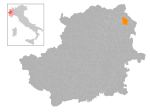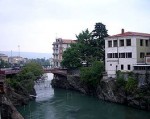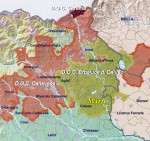Wie kent hem niet, de Erbaluce? 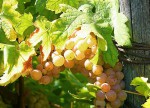
De meeste mensen dus, inclusief een hele schare professionals. Reden genoeg om extra aandacht te besteden aan deze de autochtone druif uit Caluso, de kleine wijnstreek in het noordwesten van Piëmonte op de grens met de Valle d’Aosta.
Erbaluce, who doesn’t know it?
Right, most people haven’t heard about it, including many professionals. All the more reason to pay some extra attention to this autochthonous grape from Caluso, a small wine region northwest of Piedmont at the border of Valle d’Aosta.
Who says Piedmont, thinks primarily of Nebbiolo, Barbera and Moscato, secondarily of Dolcetto, Arneis and maybe even also the Cortese or the Favorita, but rarely somebody will mention the Nascetta, Timorasso or Erbaluce. That’s a shame, because they have so much more to offer than assumed.
The producers from the region surrounding the little town of Ivrea organized, in collaboration with Gheusis, International Press Relations, a closer introduction to the area, the winemakers and a wine they were happy to present as ‘a fairytale wine’. It turned out to be a fascinating, well-organized wine trip with, indeed, a number of fairytale elements.
Ivrea is a relatively small town in the Piedmont region of Turin and the unofficial capitol of the hilly area Canavese. Straight through the city runs the river the Dora Baltea, well-known for its rafting circuit. East of the town there is La Serre, a 25km long morene rampart that terminates the composition of the soil as well as the climate of the region and its vineyards.
Ivrea was already in the 9th century an important place because of its strategic position along the road crossing the Alps between France and Italy. It owes its name to the House of Ivrea, a French originated dynasty. In modern history Ivrea is better known as home to the Olivetti-concern. Thanks to Olivetti Ivrea grew and thrived for several decades, but it also hit rock bottom after the decline of the company. Olivetti’s presence still lingers here, sometimes in a positive way, sometimes not.
To the last accomplishments, that can be attributed to Olivetti, belong the restauration of the San Bernardino church in Ivrea and the preservation of the wines from the district Carema. Since the company was drawing practically every single employee from the surrounding area to Ivrea, viticulture in Carema risked extinction. As counterpart, Olivetti took care of rehabilitation and maintenance of the vineyards and revitalized the cooperation and ensured that the DOC Carema could live on.
Glaciers didn’t only form the lake of Viverone, but also beautiful, indigent terroirs containing clay, pebbles and shale, rich in phosphorus, magnesium and potassium. Combined with the moderate temperatures in the valley (on average about 13°C and even in August hardly rising above25°C) it’s ideal for white wines, particularly for the Erbaluce. The grape lends its name to three types of wine: Erbaluce di Caluso, Caluso Passito (including Riserva) and Erbaluce di Caluso Spumante. This variety immediately indicates the versatility of this grape, the additive Caluso refers to the location of the very best vineyards.
The history of the Erbaluce grape reaches back to at least 1606, in that year it is mentioned in a book by jeweler Giovan Battista Croce, at the time of Carlo Emanuele I. Its name is based on the pale pink (up to even shades of amber) color it shows at the end of the season.
Typical for the Erbaluce is itsfresh character, partially based on a vivid, natural acidity. Its versatility is fully expressed in a broad series of wines, sparkling as well as dry and still and sweet. Obviously a grape with many advantages, because:
– Both grape and wine are autochthonous
– Both grape and wine are unique in Italy
– Both grape and wine are made exclusively in this area
– Quality on average is good to extremely good
– The wines are highly digestible and easy deployable in gastronomy
– The wines age well
– The wines are in general very affordable
About 20% of all Erbaluce is used for sparkling wines, all made on the classical way. The core however is used to make dry still white wines, pleasant, invigorating facilitators to numerous lighter but also more pronounced dishes. Sweet Erbaluce is a so called Passito, so it’s made from dried grapes, very fine wines to accompany rich courses, not just desserts. And the fact that the regional cuisine matches the several Erbaluces so well, is of course no accident.
Without any doubt, one of the top producers in this region is Orsolani. During a visit I got closer acquainted with the very enthusiastic Gian Luigi Orsolani, the current owner of the family business.
Although their history dates back to 1894, Orsolani is not one of the oldest wine families, but it’s one that’s inignorable. The founders were Orsolani Giovanni and his wife Domenica, who returned from America to start the inn “Locanda Aurora”. Domenica worked in the kitchen and Giovanni took care of the vineyards and the wines. Initially, the wine was sold only in their own inn, but soon the demand grew and production had to be extended. Slowly but surely making quality wines became their core business.
Of course, Orsolani made the traditional sweet Erbaluce, but in 1968 they introduced a sparkling version, the first in the region. In 1985 this was followed by the ‘La Rustia’, his answer to the demand for top quality dry white Erbaluce. Over the years, Gian Luigi conducted many experiments to improve its wines and, of course, the use of barriques is part of it. He is currently managing the influence of oxygen during vinification and aging. His principles are clear: oxidation is bad, aeration is good.
Orsolani is enthusiastic, motivated and convinced of the usefulness and necessity to make authentic wines. “Winemaking should never be an industry”: he says. “Wine is culture and industrial wines are an insult. Our goal is to expand the legacy of our rich history and improve where possible. We don’t need international grapes like Cabernet and Chardonnay, and we shouldn’t use them. They are not the reason for our existence. We and our wines have our own identity and are beyond compare. We have at most a similar position as other original wines like Gavi, but with our own unique characteristics. The style and character of our wines is still the same, but we see a change in the valuation. Five years ago nobody knew our wines and now they are suddenly given Tre Bicchieri in the Gambero Rosso guide. To us a confirmation that patience and quality is rewarded, even if you need to wait ‘a little while’ for recognition. The granting of the DOCG status for our Erbaluce is a new highlight in our history and emphasizes that we are on the right track. This also applies to our nurturing of old values. Retaining the pergolas and “Alteno Canavesano” for example. This arosing is no coincidence, it has a specific reason and a clear effect. They are less susceptible to night frost and the bunches are protected against abundant sunlight. We are not against Guyot, but first we do want to understand why these modern methods should suddenly be applied everywhere instead of our own traditions. We do not even know enough of the pergola and further studies seem like a logical step and better than to just go on Guyot “. Who tastes Orsolani’s wines, know that this is not just something Gian Luigi says. The proof that he’s right, is in the wines he makes.
A small selection of different producers from the region:
Favaro Benito
– Erbaluce di Caluso DOCG, Le Chiusure, 2008
Beautiful intense fragrance, filled with spicy aromas, mineral tones, floral accents and quirky fruits, persimmons, melone Cottone, pomegranates, full flavor, juicy, filling, good acidity, clean aftertaste, rich wine, poor glow in finale
– Erbaluce di Caluso DOCG, Le Chiusure, 2010
Fresh, alpine herbs, clean and pure white fruit, mineral touch, tension and juice, beautiful rounded acids in finals, good length, foodwine
Ferrando
– Erbaluce di Caluso DOCG, Cariola, 2001
Full color, golden, beautiful fragrance, ripened, but still fresh, beautiful buttery tones, buttercup, white dried fruit, tropical accents, in the mouth full of juice, balanced with a lot of juice and flavor, length, excellent balance, clean finale, with impressions of orange, honey, good acidity, full and pleasantly dry finish, very nice.
– Erbaluce di Caluso DOCG, Cariola, 2009
Beautiful intense scent, youthful, full, hints of banana, melon, blossoms, spicy with good acidity, very young, foodwine with much length, very good.
– Erbaluce di Caluso DOCG, Cariola, 2010
Full color, clearly a wine with oxygen influence, young, strong, opinionated, very juicy and with tension, many minerals, flint, beautifully.
– Caluso Passito DOC, Cariola, 1999
Deep golden brown, lots of juice and flavor, length, caramel, mocha, much tension, coffee, chocolate, figs, perfectly balanced, sweet and acidity, great length, exemplary wine
Orsolani
– Caluso Spumante DOC, Cuvee Tradizione Gran Reserva, 2006
Full round, rich fragrance, beautiful floral tones, blossom, acacia honey, powerful flavors, youthful, full of character, good acidity, mature foodwine
– Erbaluce di Caluso DOCG, La Rustia, 2009
Nice smell, full, soft, good tension, showing lots of ripe notes, rounded, fine dry finale, enough tension and length
– Erbaluce di Caluso DOCG, La Rustia, 2010
Spicy aroma, fresh, spicy, floral tones, pear, green apple, full of flavor, energetic, good acidity, length and grip, fine bitters, complete wine, very successful
Cantina Sociale del Canavese
– Caluso Passito DOC, Morenico, 2003
Relatively light color, smell of fresh pineapple, honey, full of sweet, fair acids, average tension, mocha and coffee in aftertaste, small bitter, correct
Cantina Sociale della Serra
– Caluso Spumante DOC, Serra Classic
Soft, smooth, rounded, accessible, good tension, a bit sweet, easy
– Caluso Passito DOC, 2004
Brown Yellow color, roasted caramel, coffee, light oxidative tones, cinnamon, nut, ends with a certain dryness, digestable, gastronomical
Cantina Briamara
– Caluso Passito DOC, Pescarolo, 2006
Clearly influence of oxygen, a lot of candy and roasted tones, grillee, full sweet flavor with good acidity, good tension, average refinement, ending with a lot of sweet, more than just correct
Caretto Loris Livio
– Erbaluce di Caluso DOCG 2010
Neat flavor, good balance, lighter structure, ends bone dry, aperitif style with character
Cellagrande
– Caluso Spumante DOC, Cellagrande Brut, 2003
Full, rich color, very fruity fragrance, fresh apple, partially dried, lot of taste, clear, mature, nice filling, good tension, foodwine, impressions of apples remain, tarte tatin
– Brut Rosato 5% nebbiolo
Soft pink color, fruity aroma, good flavor, fresh, hint of tannin, bite, nice and dry, stimulating, opinionated aperitif
– Erbaluce di Caluso DOCG 2010
Full flavor, well characterized with floral tones and spicy accents, some honey, in the mouth pretty tight, dry, firm, mineral touch, firm acids and bitters, very young
Cieck (Tsji-ek)
– Erbaluce di Caluso DOCG, Misobolo, 2009
Slivered white almonds, persimmon, nice juice, a little alcohol, good acidity, hint of caramel, which ends drying
– Caluso Passito DOC, Alladium 1998
Relatively light color, golden, sparkling, honey, elegance, refinement, lot of sweet, nice fruit, remarkably youthful, somewhat drying with wood accents, beautiful mineral touch, lots of length
– Caluso Passito DOC, Alladium 2004
Brown yellow in color, bit neutral in the nose, orange zest, mocha, great juice, some drying accents with wood, good acidity, sufficient fruit
Giacometto Bruno
– Erbaluce di Caluso DOCG 2010
nice smell, fruity, floral flavor, good juice, fresh acidity, misses a little youth for a 2010, but has filling and length
La Masera
– Erbaluce di Caluso DOCG, Macaria, 2007
Rich, ripe aroma, hint of white nuts, floral note, lots of juice and flavor, good balance, good acidity, great length
– Erbaluce di Caluso DOCG, Macaria, 2009
Nice smell, somewhat subdued, millefiori, spicy touch, buttercup, soft, almost sweet start, hint of mocha, candy, honey, nice balance, youthful, less size and strength than 2007, but beautiful
Picco Giuseppe
– Erbaluce di Caluso DOCG, Del Bric, 2010
Good clean smell, fresh white fruit, racy style, lean, bone dry, good balance, rather aperitif style than foodwine, like most, with good length, very clean
Tenuta Roletto
– Erbaluce di Caluso DOCG, Muline, 2008
Powerful fragrance, mineral, spicy, Alpine flowers, nice and dry, wood, slightly drying finale
Wie Piëmonte zegt, denkt in eerste instantie aan Nebbiolo, Barbera en Moscato, daarna aan Dolcetto, Arneis en misschien nog wel de Cortese of de Favorita, maar zelden zal iemand de Nascetta, Timorasso of Erbaluce noemen. Jammer, want ze hebben veel meer te bieden dan we denken.
De producenten uit de regio rond het stadje Ivrea organiseerden in samenwerking met Gheusis, International Press Relations, een nadere kennismaking met de streek, de wijnmakers en een wijn die ze graag presenteren als ‘a fairytale wine’. Het bleek een boeiende, goed georganiseerde wijnreis met inderdaad de nodige sprookjesachtige elementen.
Ivrea is een relatief klein stadje in de Piemontese provincie Turijn en de officieuze hoofdstad van de heuvelachtige streek Canavese. Dwars door de stad loopt de rivier de Dora Baltea, bekend om zijn wildwatercircuit voor kanovaarders. Ten oosten van de stad ligt La Serre, de 25 kilometer lange morenewal die de samenstelling van de bodems en het klimaat van de streek met z’n wijngaarden bepaalt.
Al in de 9e eeuw was Ivrea een belangrijke plaats door haar strategische ligging aan de weg door de Alpen tussen Frankrijk en Italië. Haar naam dankt ze aan het Huis van Ivrea, een dynastie met Franse oorsprong. In de moderne geschiedenis staat Ivrea meer bekend als thuisbasis van het Olivetti-concern.  Dankzij Olivetti groeide en bloeide Ivrea diverse decennia, maar ging het ook door een diep dal na de teloorgang van het bedrijf. De aanwezigheid van Olivetti is nog altijd voelbaar, soms in positieve- en soms in negatieve zin.
Dankzij Olivetti groeide en bloeide Ivrea diverse decennia, maar ging het ook door een diep dal na de teloorgang van het bedrijf. De aanwezigheid van Olivetti is nog altijd voelbaar, soms in positieve- en soms in negatieve zin.
Tot de laatste positieve wapenfeiten die aan Olivetti kunnen worden toegeschreven behoren de restauratie van de San  Bernardino kerk in Ivrea en het behoud van de wijnen uit het district Carema. Omdat het bedrijf vrijwel alle werknemers uit de omgeving naar Ivrea trok, dreigde de wijnbouw in Carema te verdwijnen. Als tegenprestatie zorgde Olivetti ervoor dat wijngaarden werden hersteld, onderhouden, de coöperatie nieuw leven ingeblazen en de DOC Carema kon blijven bestaan.
Bernardino kerk in Ivrea en het behoud van de wijnen uit het district Carema. Omdat het bedrijf vrijwel alle werknemers uit de omgeving naar Ivrea trok, dreigde de wijnbouw in Carema te verdwijnen. Als tegenprestatie zorgde Olivetti ervoor dat wijngaarden werden hersteld, onderhouden, de coöperatie nieuw leven ingeblazen en de DOC Carema kon blijven bestaan.
Gletsjers hebben niet alleen het meer van Viverone gevormd, maar ook prachtige, arme terroirs met klei, kiezel en leisteen, rijk aan fosfor, magnesium en kalium. Samen met de gematige temperaturen in de vallei (gemiddeld bijna 13°C en zelfs in augustus nauwelijks boven de 25°C) zijn ze ideaal voor witte wijnen, ideaal voor de Erbaluce. De druif geeft zijn naam aan drie typen wijn: Erbaluce di Caluso, Caluso Passito (inclusief Riserva) en Erbaluce di Caluso Spumante. Deze variatie geeft al meteen aan hoe veelzijdig de druif is, waarbij de toevoeging Caluso naar het plaatsje verwijst waar de beste wijngaarden liggen.
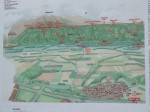

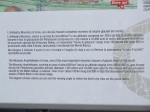
De geschiedenis van de Erbaluce druif gaat in ieder geval terug tot 1606, in dat jaar wordt hij genoemd in een boek van juwelier Giovan Battista Croce, ten tijde van Carlo Emanuele I. Zijn naam ontleent hij aan de zachtroze (tot zelfs amber) tint die hij aan het eind van het seizoen krijgt.
Kenmerkend voor de Erbaluce is zijn frisse karakter, deels gebaseerd op een mooie, levendige natuurlijke zuurgraad. De veelzijdigheid komt volledig tot uitdrukking in een brede reeks wijnen, zowel mousserend als droog en stil en zoet. Een druif met pluspunten dus, want
– druif en zijn wijnen zijn autochtoon
– de druif en zijn wijnen uniek in Italië
– de druif en zijn wijnen zijn exclusief voor de streek
– de gemiddelde kwaliteit is goed tot zeer goed
– de wijnen zijn uiterst verteerbaar en prima in te zetten in de gastronomie
– de wijnen ouderen goed
– de wijnen zijn over het algemeen prima te betalen
Zo’n 20% van de Erbaluce wordt gebruikt voor mousserende wijnen, allen gemaakt volgens de klassieke methode. De kern wordt echter gevormd door de droge stille witte wijnen, aangename, opwekkende begeleiders van tal van lichtere en ook meer geprononceerde gerechten. Zoete Erbaluce is een zogenaamde passito en dus gemaakt van ingedroogde druiven, fijne begeleiders van rijke gangen, niet uitsluitend desserts. En dat de regionale keuken uitstekend past bij de diverse Erbaluces is natuurlijk geen toeval.
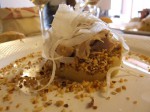
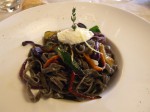
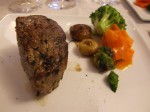

Tot de topproducenten uit de streek behoort zonder enige twijfel Orsolani. Tijdens een bezoek maakte ik nader kennis met de zeer bevlogen Gian Luigi Orsolani,  de huidige eigenaar van het familiebedrijf.
de huidige eigenaar van het familiebedrijf.
Hoewel hun geschiedenis teruggaat tot 1894, is Orsolani niet één van de oudste wijnfamilies, maar er wel één waar men niet omheen kan. De grondleggers waren Giovanni Orsolani en zijn vrouw Domenica, die terugkeerde uit Amerika om de herberg “Locanda Aurora” te beginnen. Domenica werkte in de keuken en Giovanni verzorgde de wijngaarden en de wijnen. In eerste instantie werd de wijn alleen in de eigen herberg verkocht, maar al snel groeide de vraag en moest de productie worden uitgebreid. Langzaam maar zeker werd het maken van kwaliteitswijnen hun voornaamste werk.
Uiteraard maakte Orsolani de traditionele zoete Erbaluce, 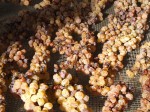 maar in 1968 introduceerde men een mousserende versie, de eerste in de streek. In 1985 werd deze gevolgd door de ‘La Rustia‘, zijn antwoord op de vraag naar topkwaliteit droge witte Erbaluce. In de loop van de jaren heeft Gian Luigi talloze experimenten uitgevoerd om zijn wijnen te verbeteren en uiteraard maakt het gebruik van barriques daar onderdeel van uit. Momenteel werkt hij aan het beheersen van de invloed van zuurstof tijdens de vinificatie en lagering. Zijn uitgangspunten is duidelijk: oxidatie is slecht, beluchting is goed.
maar in 1968 introduceerde men een mousserende versie, de eerste in de streek. In 1985 werd deze gevolgd door de ‘La Rustia‘, zijn antwoord op de vraag naar topkwaliteit droge witte Erbaluce. In de loop van de jaren heeft Gian Luigi talloze experimenten uitgevoerd om zijn wijnen te verbeteren en uiteraard maakt het gebruik van barriques daar onderdeel van uit. Momenteel werkt hij aan het beheersen van de invloed van zuurstof tijdens de vinificatie en lagering. Zijn uitgangspunten is duidelijk: oxidatie is slecht, beluchting is goed.
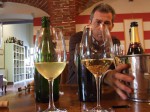 Orsolani is bevlogen, gedreven en overtuigd van het nut en de noodzaak om toch vooral authentieke wijnen te maken. “Wijn zou geen industrie mogen zijn”: zo stelt hij. “Wijn is cultuur en industriële wijnen zijn een belediging. Ons doel is de nalatenschap van onze rijke geschiedenis uit te breiden en waar mogelijk te verbeteren. Internationale druiven als Cabernet en Chardonnay hebben we niet nodig en zouden we niet moeten gebruiken. Zij zijn immers niet de reden van ons bestaan. Wij en onze wijnen hebben onze eigen identiteit en zijn met niets te vergelijken. We hebben hooguit een vergelijkbare positie met bijvoorbeeld andere originele wijnen zoals de Gavi, maar dan met onze eigen, unieke kenmerken. De stijl en het karakter van onze wijnen is nog altijd dezelfde, maar we zien wel een verandering in de waardering ervan. Vijf jaar geleden kende niemand onze wijnen en nu krijgen ze ineens Tre Bicchieri in een gids als de Gambero Rosso. Voor ons een bevestiging dat geduld en kwaliteit lonen, ook al moet je ‘even’ op de erkenning wachten. De toekenning van de DOCG-status voor onze Erbaluce is een nieuw hoogtepunt in onze geschiedenis en benadrukt dat we de juiste koers volgen. Dat geldt ook voor het koesteren van oude waarden. Het behouden van de pergola’s en “Alteno Canavesano” bijvoorbeeld.
Orsolani is bevlogen, gedreven en overtuigd van het nut en de noodzaak om toch vooral authentieke wijnen te maken. “Wijn zou geen industrie mogen zijn”: zo stelt hij. “Wijn is cultuur en industriële wijnen zijn een belediging. Ons doel is de nalatenschap van onze rijke geschiedenis uit te breiden en waar mogelijk te verbeteren. Internationale druiven als Cabernet en Chardonnay hebben we niet nodig en zouden we niet moeten gebruiken. Zij zijn immers niet de reden van ons bestaan. Wij en onze wijnen hebben onze eigen identiteit en zijn met niets te vergelijken. We hebben hooguit een vergelijkbare positie met bijvoorbeeld andere originele wijnen zoals de Gavi, maar dan met onze eigen, unieke kenmerken. De stijl en het karakter van onze wijnen is nog altijd dezelfde, maar we zien wel een verandering in de waardering ervan. Vijf jaar geleden kende niemand onze wijnen en nu krijgen ze ineens Tre Bicchieri in een gids als de Gambero Rosso. Voor ons een bevestiging dat geduld en kwaliteit lonen, ook al moet je ‘even’ op de erkenning wachten. De toekenning van de DOCG-status voor onze Erbaluce is een nieuw hoogtepunt in onze geschiedenis en benadrukt dat we de juiste koers volgen. Dat geldt ook voor het koesteren van oude waarden. Het behouden van de pergola’s en “Alteno Canavesano” bijvoorbeeld. 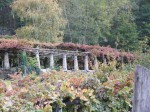 Dat deze zijn ontstaan is geen toeval, dat heeft een specifieke reden en een duidelijk effect. Zo zijn ze minder gevoelig voor vorst aan de grond en beschermen ze de trossen tegen overvloedig zonlicht. We zijn niet tegen Guyot, maar willen wel eerst begrijpen waarom we deze moderne methode nu ineens overal zouden moeten toepassen in plaats van onze eigen tradities. We weten nog niet eens genoeg van de pergola en deze verder onderzoeken lijkt me een logischer en betere stap dan zomaar over te gaan op Guyot”. Wie de wijnen van Orsolani proeft, weet dat Gian Luigi dit niet zomaar zegt. Het bewijs van zijn gelijk zit in de wijnen die hij maakt.
Dat deze zijn ontstaan is geen toeval, dat heeft een specifieke reden en een duidelijk effect. Zo zijn ze minder gevoelig voor vorst aan de grond en beschermen ze de trossen tegen overvloedig zonlicht. We zijn niet tegen Guyot, maar willen wel eerst begrijpen waarom we deze moderne methode nu ineens overal zouden moeten toepassen in plaats van onze eigen tradities. We weten nog niet eens genoeg van de pergola en deze verder onderzoeken lijkt me een logischer en betere stap dan zomaar over te gaan op Guyot”. Wie de wijnen van Orsolani proeft, weet dat Gian Luigi dit niet zomaar zegt. Het bewijs van zijn gelijk zit in de wijnen die hij maakt.
Een greep uit het aanbod van verschillende producenten uit de streek:
 Favaro Benito
Favaro Benito
– Erbaluce di Caluso DOCG, Le Chiusure, 2008
Mooi intense geur, gevuld met kruidige aroma’s minerale toets, florale accenten en eigenzinnig fruit, kaki, melone cottone, granaatappel, volle smaak, sappig, vullend, mooie zuren, schone afdronk, rijke wijn, arme gloed in finale
– Erbaluce di Caluso DOCG, Le Chiusure, 2010
Fris, Alpenkruiden, schoon en puur wit fruit, minerale toets, spanning en sap, mooie afgeronde zuren in finale, prima lengte, eetwijn
Ferrando
– Erbaluce di Caluso DOCG, Cariola, 2001
Volle kleur, goudgeel, prachtige geur, gerijpt, maar nog fris, mooie boterige tonen, boterbloem, gedroogd wit fruit, tropische accenten, in de mond vol sappig, evenwichtig met veel sap en smaak, lengte, uitstekende balans, schone finale, met impressies sinaasappel, honing, mooie zuren, eindigt vol en aangenaam droog, zeer fraai.
– Erbaluce di Caluso DOCG, Cariola, 2009
Mooie intense geur, jeugdig, vol, hint banaan, meloen, bloesem, kruidig met mooie zuren, heel jong, eetwijn met veel lengte, zeer goed.
– Erbaluce di Caluso DOCG, Cariola, 2010
Volle kleur, duidelijk een wijn met invloed zuurstof, jong, krachtig, eigenzinnig, veel sap en spanning, veel mineralen, vuursteen, fraai.
– Caluso Passito DOC, Cariola, 1999
Diep goudbruin, veel sap en smaak, lengte, karamel, mokka, veel spanning, koffie, chocolade, vijgen, perfect balans, zoet en zuren, grootse lengte, voorbeeldige wijn
 Orsolani
Orsolani
– Caluso Spumante DOC, Cuvee Tradizione Gran Reserva, 2006
Volle ronde, rijke geur, mooie florale tonen, bloesem, acaciahoning, krachtige smaak, jeugdig, veel karakter, mooie zuren, volwassen eetwijn
– Erbaluce di Caluso DOCG, La Rustia, 2009
Mooie geur, vol, zacht, goede spanning, veel rijpe tonen, afgerond, goed droge finale, voldoende spanning en lengte
– Erbaluce di Caluso DOCG, La Rustia, 2010
Pittige geur, fris, kruidig, florale tonen, peer, rinse appel, vol van smaak, doortastend, mooie zuren, grip en lengte, fijn bittertje, complete wijn, zeer geslaagd
Cantina Sociale del Canavese
– Caluso Passito DOC, Morenico, 2003
Relatief lichte kleur, geur van verse ananas, honing, vol zoet, redelijke zuren, gemiddelde spanning, mokka en koffie in afdronk, klein bittertje, correct
Cantina Sociale della Serra
– Caluso Spumante DOC, Serra Classic
Zacht, soepel, afgerond, laagdrempelig, goede spanning, klein zoetje, makkelijk
– Caluso Passito DOC, 2004
Bruingele kleur, gebrande karamel, koffie, licht oxidatieve tonen, kaneel, noot, eindigt met zekere droogheid, verteerbaar, gastronomisch
Cantina Briamara
– Caluso Passito DOC, Pescarolo, 2006
Duidelijk invloed van zuurstof, veel kandij en geroosterde tonen, grillée, vol zoet van smaak met mooie zuren, goede spanning, gemiddelde verfijning, eindigt met erg veel zoet, meer dan correct
Caretto Loris Livio
– Erbaluce di Caluso DOCG 2010
Nette smaak, goede balans, lichtere structuur, eindigt beendroog, aperitiefstijl met karakter
Cellagrande
– Caluso Spumante DOC, Cellagrande Brut, 2003
Volle, rijke kleur; goed fruitrijke geur, verse appel, deels gedroogd; veel smaak, duidelijk, gerijpt, mooie vulling, goede spanning, eetwijn, impressies van appels blijven, tartatin
– Brut Rosato 5% nebbiolo
Zachtroze van kleur, fruitrijke geur, goed van smaak, fris, hint tannine, bite, mooi droog, opwekkend, eigenzinnig aperitief
– Erbaluce di Caluso DOCG 2010
Volle geur, goed getypeerd met kruidige tonen florale accenten en kruidige toets, wat honing, in de mond vrij strak, droog, krachtig, minerale toets, stevige zuren en bitters, nog heel jong
Cieck (Tsji-ek)
– Erbaluce di Caluso DOCG, Misobolo, 2009
geschaafde blanke amandelen, kaki, mooi sap, beetje alcoholisch, goede zuren, hint karamel, eindigt wat drogend
– Caluso Passito DOC, Alladium 1998
Vrij lichte kleur, goudgeel, fonkelend, honing, elegant, verfijning, veel zoet, mooi fruit, opvallend jeugdig, wel wat drogende accenten van hout, mooie minerale toets, veel lengte
– Caluso Passito DOC, Alladium 2004
Bruingeel van kleur, wat neutraal in de neus, sinaasappelzest, mokka, goed sap, wat drogende accenten van hout, goede zuren, voldoende fruit
Giacometto Bruno
– Erbaluce di Caluso DOCG 2010
mooie geur, fruitrijk, bloemige tonen, goed sap, frisse zuren, mist ietsje jeugd voor een 2010, maar vulling en lengte
La Masera
– Erbaluce di Caluso DOCG, Macaria, 2007
Rijke, gerijpte geur, hint blanke noten, florale toets, veel sap en smaak, mooie balans, prima zuren, veel lengte
– Erbaluce di Caluso DOCG, Macaria, 2009
Mooie geur, iets ingetogen, millefiori, kruidige toets, boterbloem, zachte, bijnan zoete aanzet, hint mokka, kandij, honing, mooie balans, jeugdig, minder lengte en kracht dan 2007, maar mooi
Picco Giuseppe
– Erbaluce di Caluso DOCG, Del Bric, 2010
Goed schone geur, fris wit fruit, rassige stijl, slank, beendroog, goede balans, eerder aperitiefstijl dan eetwijn, zoals de meeste, wel goede lengte, heel schoon
Tenuta Roletto
– Erbaluce di Caluso DOCG, Muline, 2008
Krachtige geur, mineraal, kruidig, Alpenbloemen, mooi droog, hout, iets drogende einde
